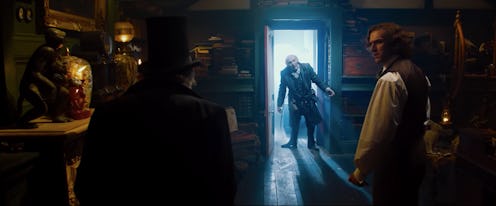Books
'A Christmas Carol' Was Actually A Major Political Protest Novel
Christmas is huge. It starts around the end of October and finishes in late January, when that tree in your living room finally dries out enough to become a major fire hazard. And while people all across the globe have wildly different ways of celebrating, we can all name the key elements that make up a "traditional" Christmas: a Christmas tree, a Christmas dinner, Christmas caroling and cards, gift giving, charity, and (hopefully) joyful time spent with family. Sure, the whole pine tree thing has more to do with ancient European paganism than it does with Bethlehem, but it's tempting to think that these classic Christmas traditions have always been integral to the most wonderful time of the year. They haven't.
"Traditional" Christmas is less than 200 years old, in fact. The spirit of merriment that we associate with the holidays doesn't come from ancient texts, but from a political protest book written in 1843. Yes, Mariah Carey owes her biggest song of all time to none other than author, social critic, and real life ghost-buster, Charles Dickens.
On December 19th, 1843, Dickens published a novella called A Christmas Carol. Dickens had written the little book in six weeks and rushed it to print, hoping to make some extra money now that his book sales were down and his wife, Catherine, was expecting their fifth child. By Christmas Eve, the first edition of A Christmas Carol had entirely sold out.
Christmas celebrations had actually been falling out of fashion at the time in England. Old customs like carols, 12-day feasts, and Father Christmas had all but faded away, and the Christmas tree was still a new-fangled fad from Germany. Some of the more puritanical Christian leaders felt that pagan traditions and decadence had no place in a Christian holiday, away, and many businesses didn't offer time off to celebrate.
It was the end of the Industrial Revolution after all, and most of England was poor. Child labor was common. Working conditions were generally abysmal. Charles Dickens had firsthand experience with this: as a child, he was forced to leave school and work 10-hour days in a boot-blacking warehouse for six schillings a week, in order to support his family. By 1843, he was already a successful author, but the memory of brutal childhood poverty never left him. He toured factories, mines, and government run schools, and was consistently appalled by the abuse of working class children.
The most widespread theories of how to "help" the poor at the time revolved around getting the poor to "help themselves." The idea was that work-houses and prisons should be unpleasant, so poor people would be motivated to work harder and improve their station in life. The scholar Rev. Thomas Malthus had a popular theory that the poor should simply be allowed to starve, and “decrease the surplus population,” as Scrooge himself would put it.
Dickens did not agree. He was planning to write his own protest pamphlet titled An Appeal to the People of England, on behalf of the Poor Man's Child, to be published at the end of the year... but the more he thought about it, the more he worried that people would only care if he presented his social justice ideas through the lens of a story.
So he added in characters: a miserly old man, a sick little boy, and several festive ghosts. The story of Ebenezer Scrooge was an instant hit.
Dickens' version of Christmas was infectious. First of all, Victorians were all about ghosts, and second of all, Dickens offered a new kind of Christmas, one that centered on family and children and helping others. It was nostalgic for many who, like Dickens himself, had known happier times in early childhood, before being forced into the workforce too young. And it was politically charged, suggesting that employers are morally obligated to treat their employees well and pay them a living wage.
A Christmas Carol remixed both old and new Yuletide traditions, and suddenly carols and feasts were back in vogue. Father Christmas took on the jolly, child-friendly nature of the Ghost of Christmas Present. Christmas began to emerge as a time for families to come together and celebrate, even if they, like the Cratchits, didn't have much money. People even started saying "Merry Christmas" on the regular.
Most importantly, though, Dickens gave us all Ebenezer Scrooge, a man who embodied the popular Victorian politics of the time. Dickens forced both Scrooge and his readers to face the consequences of greed: Tiny Tim will die and then you will also die, alone. Is that what you want, Malthusian economists? Do you want to die joyless, with no love in your life? Or will you allow these terrifying Christmas ghosts to remind you that poor people are also human beings?
Dickens' much loved story cemented many of the Christmas traditions we know and love, from singing to eating to sending cards. But he truly transformed Christmas by turning it into a holiday of generosity. He gave us so-called "Spirit of Christmas."
We can't say for certain what Dickens would have thought about the modern, ultra-capitalist monstrosity that Christmas has become (I mean, on the one hand he was pro-charity, but on the other hand, he was hugely disappointed that A Christmas Carol didn't make him more money, so... go figure). When people complain that Christmas is "too commercial" though, the Christmas that they're harkening back to is the humanist holiday that Dickens helped invent.
He was so associated with the holiday that when Dickens died in 1870, a young street vendor was famously overheard asking, "Dickens dead? Then will Father Christmas die, too?"
Lucky for us, though, while Charles Dickens might be gone, Dickens' Christmas is still with us today.
